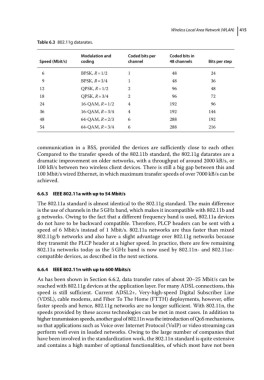Page 429 - From GMS to LTE
P. 429
Wireless Local Area Network (WLAN) 415
Table 6.3 802.11g datarates.
Modulation and Coded bits per Coded bits in
Speed (Mbit/s) coding channel 48 channels Bits per step
6 BPSK, R = 1/2 1 48 24
9 BPSK, R = 3/4 1 48 36
12 QPSK, R = 1/2 2 96 48
18 QPSK, R = 3/4 2 96 72
24 16‐QAM, R = 1/2 4 192 96
36 16‐QAM, R = 3/4 4 192 144
48 64‐QAM, R = 2/3 6 288 192
54 64‐QAM, R = 3/4 6 288 216
communication in a BSS, provided the devices are sufficiently close to each other.
Compared to the transfer speeds of the 802.11b standard, the 802.11g datarates are a
dramatic improvement on older networks, with a throughput of around 2000 kB/s, or
100 kB/s between two wireless client devices. There is still a big gap between this and
100 Mbit/s wired Ethernet, in which maximum transfer speeds of over 7000 kB/s can be
achieved.
6.6.3 IEEE 802.11a with up to 54 Mbit/s
The 802.11a standard is almost identical to the 802.11g standard. The main difference
is the use of channels in the 5 GHz band, which makes it incompatible with 802.11b and
g networks. Owing to the fact that a different frequency band is used, 802.11a devices
do not have to be backward compatible. Therefore, PLCP headers can be sent with a
speed of 6 Mbit/s instead of 1 Mbit/s. 802.11a networks are thus faster than mixed
802.11g/b networks and also have a slight advantage over 802.11g networks because
they transmit the PLCP header at a higher speed. In practice, there are few remaining
802.11a networks today as the 5 GHz band is now used by 802.11n‐ and 802.11ac‐
compatible devices, as described in the next sections.
6.6.4 IEEE 802.11n with up to 600 Mbits/s
As has been shown in Section 6.6.2, data transfer rates of about 20–25 Mbit/s can be
reached with 802.11g devices at the application layer. For many ADSL connections, this
speed is still sufficient. Current ADSL2+, Very‐high‐speed Digital Subscriber Line
(VDSL), cable modems, and Fiber To The Home (FTTH) deployments, however, offer
faster speeds and hence, 802.11g networks are no longer sufficient. With 802.11n, the
speeds provided by these access technologies can be met in most cases. In addition to
higher transmission speeds, another goal of 802.11n was the introduction of QoS mechanisms,
so that applications such as Voice over Internet Protocol (VoIP) or video streaming can
perform well even in loaded networks. Owing to the large number of companies that
have been involved in the standardization work, the 802.11n standard is quite extensive
and contains a high number of optional functionalities, of which most have not been

